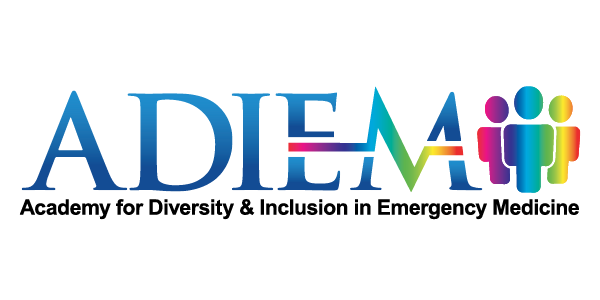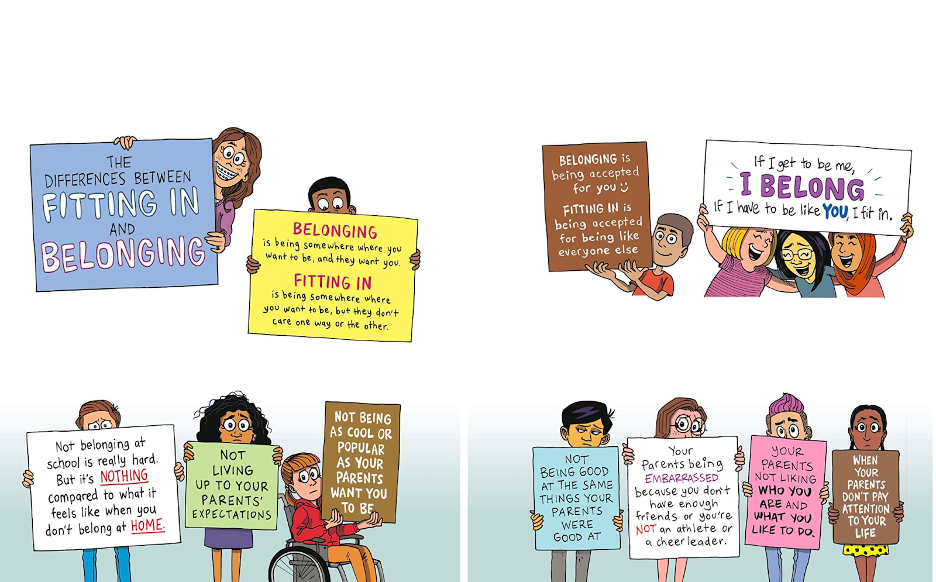
Belonging
The Role of Belonging: Diversity, Equity, and Inclusion in Medicine
Author(s): Sydney Cadiz, MD & Al’ai Alvarez, MD
Editor: Dennis Hsieh, MD & Emily Binstadt, MD, MPH
Definition(s) of Terms
Starting with a common understanding of key words, phrases, and potentially misunderstood related terms in DEI discussions helps ensure that all participants feel informed and welcome to participate in the discussion. Some terms have multiple definitions provided to help highlight nuances in the definitions.
Belonging: is “the feeling of security and support when there is a sense of acceptance, inclusion, and identity for a member of a certain group. It is when an individual can bring their authentic self to work because of psychological safety. This results from an environment of inclusion.”
Conversations and efforts on inclusion should consider belonging. Inclusion leads to belonging. Belonging is thus a feeling, while inclusion is action-driven(1).
Synonyms/Related Terms
This section highlights the definitions of other words that may be used in discussion of this topic. Sometimes these words can be used interchangeably with the terms defined above, and sometimes they may have been used interchangeably historically, but have distinct meanings in DEI conversations that it is helpful to recognize.
Diversity: is “the practice or quality of having present people from various social and ethnic backgrounds and of different genders, sexual orientations, etc.”
Inclusion: is “the action or state of incorporating/involving or being embraced within a group or structure.”
Representation: is “speaking or acting on behalf of someone.”
Awareness: is “understanding of who is being included and who is being excluded in our work.”
Authenticity: is “offering space to share personal perspectives” through “the daily practice of letting go of who we think we’re supposed to be and embracing who we are.”--Dr. Brené Brown
Psychological Safety: is “the belief that one will not be punished or humiliated for speaking up with ideas, questions, concerns, or mistakes and that the team is safe for interpersonal risk-taking"--Dr. Amy Edmondson Thus, one is “able to show and employ one’s self without fear of negative consequences of self-image, status, or career.”
Accountability: is “being aware of each of our privileges and how it impacts others’ sense of belonging.”
Invisibility: is “a function of disconnection and dehumanization, where an individual or group’s humanity and relevance are unacknowledged, ignored, and/or diminished in value or importance.”--Dr. Brené BrownScaling This Resource: Recommended Use
As many users may have varying amounts of time to present this material, the authors have recommended which resources they would use with different timeframes for the presentation.
For a 5-minute presentation: Definitions. Highlight the difference between equity and equality and discuss how the differences impact inclusion and belonging. You could use the Venn diagram here.
For a 30-minute presentation: use Diversity 3.0 as a discussion point to differentiate challenges in belonging and inclusion. Discuss the role of mentorship in developing a sense of belonging.
For an hour-long presentation: consider discussing imposter syndrome, bias, and microaggression and how these impact one’s sense of belonging. Tie this to why diversity alone cannot be successful without efforts to address imposter syndrome, bias, and microaggressions. Discuss the role of mentorship in developing a sense of belonging. Discuss institutional support and additional strategies to create a sense of belonging and accountability. Consider reviewing one of the articles provided here as a prompt for discussion or using one of these discussion prompts.
Discussion/Background
This section provides an overview of this topic so that an educator who is not deeply familiar with it can understand the basic concepts in enough detail to introduce and facilitate a discussion on the topic. This introduction covers the importance of this topic as well as relevant historical background.
Efforts to address diversity, equity, and inclusion gained momentum during the Civil Rights era. Dr. Marc Nivet, the chief diversity officer of the Association of American Medical Colleges (AAMC), wrote a timeline of efforts from Diversity 1.0 to Diversity 3.0.
Diversity 1.0 focused on diversity as an end unto itself. This was seen in recruitment, compliance, and retention efforts, focusing on counting different entities. The focus was mainly on diversity in constituents rather than on leadership roles. Diversity alone does not imply inclusion. Examples included diversity quotas and affirmative action.
Diversity 2.0 incorporated the additive contribution of diversity in learning and education. Since the 1980s, academia found that the diversity of trainees enhanced the educational environment for all, including a focus on service, self-awareness, and cultural competency for all students. Therefore, efforts on inclusion and retention had more significance than simply meeting quotas and began to shift towards models of excellence. This included efforts to foster the success of those underrepresented in medicine, especially those considered racial and ethnic minorities. Unfortunately, diversity was not yet part of the institution's core mission, so it was under resourced.
Belonging efforts started to become incorporated into Diversity, Equality, and Inclusion (DEI) programs, yet these efforts needed more appropriate resources to support the success of underrepresented groups. Examples in this version included mentorship, pipeline programs, and scholarships for underrepresented students.
Diversity 3.0 aims to shift the paradigm to leverage diversity as a vehicle for excellence.
Diversity plus inclusion becomes a strategic imperative toward innovation in high-performing organizations.(2) Examples of Diversity 3.0 include a holistic review of applications, bias training, sponsorship, and intentional efforts to improve representation in all levels of leadership, accountability using additional incentive funds for departments on diversity and inclusion climate scores, and overall program support for efforts on DEI.(3) Institutional buy-in, promotion, and allocation of funds and resources are critical for the success of Diversity 3.0 efforts. Without sustained institutional support, individual efforts will come across as performative or fall under the shoulders of those already minoritized, adding to the diversity tax.
Cultivating belonging requires awareness, authenticity, psychological safety, and accountability.(4) Awareness includes the understanding of who is being included and who is being excluded in our work. Authenticity is offering space to share personal perspectives. Inherent in authenticity and, therefore, belonging is psychological safety, or “being able to show and employ one’s self without fear of negative consequences of self-image, status, or career.”(5) Lastly, accountability is being aware of each of our privileges and how it impacts others’ sense of belonging.
According to Vernā Myers, “Diversity is being invited to the party. Inclusion is being asked to dance.” Belonging is being comfortable enough to dance like no one’s watching and being able to choose the music. Accountability supports belonging by being willing to offer different music to make everyone feel welcome. Diversity 3.0 aims to ensure belonging for members of diverse groups.
Quantitative Analysis/Statistics of note
This section highlights the objective data available for this topic, which can be helpful to include to balance qualitative or persuasive analysis or to help define a starting point for discussion.
There has been a continued decline in Black male applicants and matriculants to medical school since 1978 despite the increased representation of traditionally underrepresented groups in medicine.(6) At the same time, the 2022-2023 data on matriculants to medical school highlights some improvement: “The number of Black or African American matriculants increased by 9%. Black or African American students comprised 10% of matriculants in 2022-23, up from 9.5% in 2020-21. First-year Black or African American men increased by 5%. Matriculants who are Hispanic, Latino, or of Spanish origin increased by 4%. Individuals from this group made up 12% of total matriculants. American Indian or Alaska Native matriculants declined by 9%, comprising 1% of matriculants. On the gender front, women continued to make gains in 2022-23, making up 57% of applicants, 56% of matriculants, and 54% of total enrollment. Women comprised most of these three groups for the fourth year in a row. According to the data, 2022-23 was the first time in seven years that the number of men matriculants did not decline.”(7)
UiM (underrepresented in medicine) remains underrepresented at all levels of academic medicine.(8) Reasons include lower rates of promotions(9), a higher sense of isolation, and lower career satisfaction(10). Structural racism also impacts one’s sense of inclusion. Black scientists were 13% less likely to receive NIH funding than White scientists(11).
Mentorship is essential in overcoming the barriers listed above, yet formal mentorship for faculty and trainees is only sometimes available, with less than 50% of UiM faculty having formal mentorship(12).
Slide presentation or Images
Images and graphical representations in presentations can clarify concepts and enhance interest. Please cite the sources of these images appropriately is you use them in your presentation, found in the last section of this page. We purposefully avoided providing complete slide decks in this curriculum, and instead opted to offer easy building blocks for a great personalized presentation regardless of the format.
These sources have images that may be helpful to explain the concept of Belonging visually in a presentation. The context for each image is given in the cited source.
1) Venn Diagram of Diversity, Equity, Inclusion, and Belonging. Source here.(13)
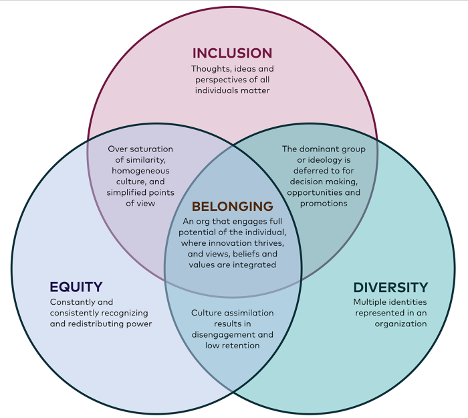
Each element represents a different piece of the full human experience. Addressing only one or two of these falls short of gaining what I think is the full human experience — a sense of belonging.
2) Creating sustainable efforts on DEI requires understanding beyond entities and metrics.(14)
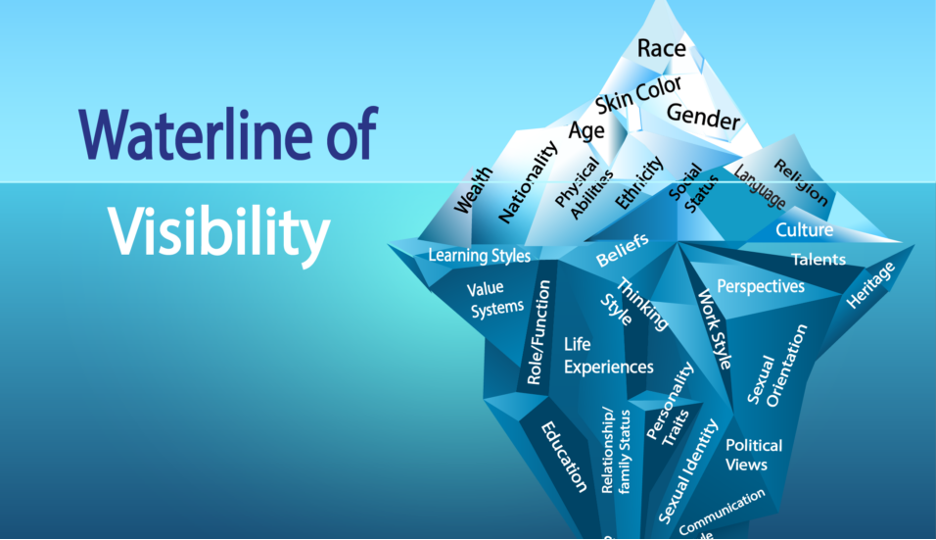
3) How organizations can foster belonging.(15)
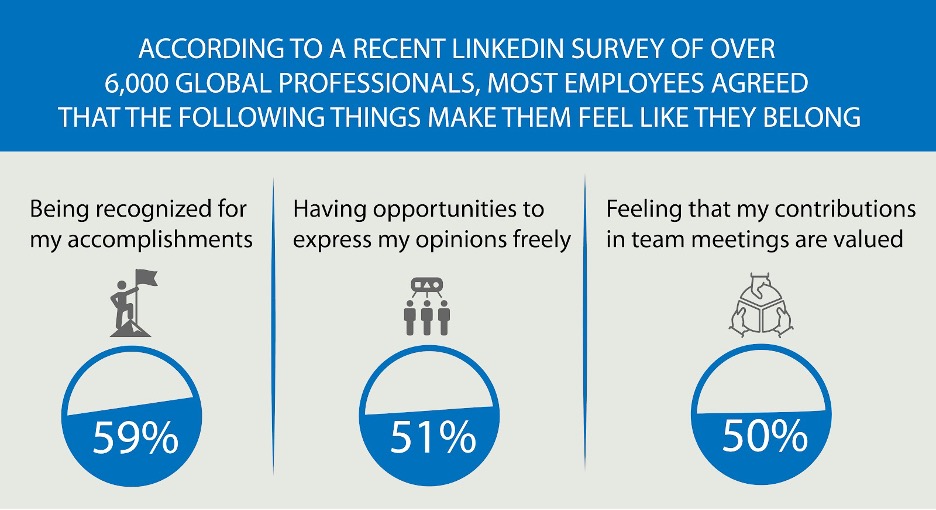
4) The difference between “fitting in” or assimilation and a true sense of belonging.(16)
Role-playing Scenario
Role-playing scenarios can enhance investment and participation. Always consider psychological safety when asking participants to engage in any role-playing activity to avoid potential adverse effects. We highly recommend a discussion for each group to agree on ground rules of respectful learning prior to engaging in any role-playing scenarios (embrace ambiguity, commit to learning together, listen actively, create a brave space, suspend judgment, etc.). It is reasonable to review these ground rules prior to each role-playing discussion.
- Psychological safety must be maintained and intentionally addressed if one is to do role-playing. Here’s a resource on creating inclusive spaces.
Role-play a scenario that fosters psychological safety. What would it look like to discuss bias and discrimination at work that includes different viewpoints and also creates space for people to share their discomfort, biases, and shortcomings?
Prompt: What specific initiative could your workplace usher in to be more inclusive of groups UiM? What are potential gains and shortcomings? - Role-play example: Your workplace just started paid maternity leave.
Gains: Paid maternity leave helps make medical careers more accessible to cisgender women of childbearing age.
Shortcomings: What groups are excluded? Cisgender men would not qualify for paid leave, not even if the men were single parents. Transgender men or gender nonbinary individuals assigned female at birth may be excluded by the term “maternity.”
Once participants identify shortcomings, How could a maternity leave policy become more inclusive? - Participants may reflect on the scenarios of microaggressions mentioned in this article and how to address them.(28) How may participants apply these specific frameworks for action in a medical setting?
Barriers/Challenges/Controversies
This section should help the facilitator anticipate any questions, naysayers, rebuttals, or other feedback they may encounter when presenting the topic and allow preparation with thoughtful responses. Facilitators may experience concerns about their personal ability to present a specific DEI topic (i.e. a white facilitator presenting on antiracism or minority tax), and this section may address some of those tensions.
Critical barriers to belonging are the need for institutional support and mentorship. Intentional efforts to include underrepresented groups are often met by concerns of “reverse” or “variable” discrimination, which in recent years have affected efforts on recruitment. Here is an example of a lawsuit.(17) This article on quotas and affirmative action offers some responses to why we need and should embrace these types of policies.(18)
Another barrier to belonging is a need for more mentorship, which is tied to the expectations of UiM faculty to mentor without supporting them in time and funding. This is also known as diversity or minority tax.( 19)
What other barriers have you identified or experienced?
Ethical Issues
This section may be useful to hospital ethics committees who want to increase their DEI awareness as part of monthly meetings, or to other groups who are interested in the ethical underpinnings of the topic.
What happens if you create diversity, inclusion, and belonging without accountability?
It’s important to note that these are complex problems that do not have clear answers. Creating a space for discussing these issues is critical in understanding the problem and perhaps developing solutions unique to your department/workplace.
Examples of Mentorship/Opportunities for UiM engagement
Although mentorship alone does not guarantee a sense of belonging, mentorship and pipeline programs, improve the representation of groups UiM within programs and throughout all levels of leadership. Increased representation can improve belonging and psychological safety. Below are examples of such efforts:
- The Stanford LEAD program(21) is an example of an institutional effort to provide leadership capacity building for UiM trainees.(22)
- Highland’s Mentoring in Medicine & Science (MIMS) and Emergency Medical Services (EMS) Corps.
- Summer Urban Health Fellowship - Harbor UCLA Department of Family Medicine
- California Health Care Foundation's Efforts on Diversity, Equity, and Inclusion
Journal Club Article links
A journal club facilitator can access several salient publications on this topic below. Alternatively, an article can be distributed ahead of a presentation to prompt discussion or to provide a common background of understanding. Descriptions and links to articles are provided.
- Mentorship and Women in Medicine: Deliberate efforts to have a woman-focused professional organization enhance members’ career retention and advancement and cultivate a sense of belonging.(23)
- Diversity Matters. A Career Spent Looking for a Sense of Belonging: a personal account of a faculty in emergency medicine and his encounters with racism and looking for a sense of belonging.(24)
- Belongingness in Medicine: A Critical Link in Advancing Justice, Equity, Diversity, and Inclusion: A summary of the impact of bias in medicine and how a shift towards belongingness can overcome barriers in equity and inclusion.(25)
- When screens become mirror: Black women in medicine: an argument for the power of social media to cultivate belonging.(26)
- Belonging and Combatting Physician Burnout. Another article that connects a sense of belonging and inclusion to physician well-being.( 27)
Discussion Questions
The questions below could start a meaningful discussion in a group of EM physicians on this topic. Consider brainstorming follow-up questions as well.
- How have you felt isolated in medicine? [anticipate discussions about microaggression, unprofessionalism, bias, racism]
- In times when isolation was identified, were you able to talk about it?
- If so, what conversations were helpful? What discussions did not help?
- How have you felt a sense of belonging in medicine?
- When you did, what/how do you think that was achieved? What were the key factors/drivers?
- What are ways that we can improve one’s sense of belonging? From a personal level, what can you do? From a unit/department level, what can we do? From an organizational level, what can we do?
- How do you create both belonging and accountability?
Summary/Take-home Themes
The authors summarize their key points for this topic below. This could be useful to create a presentation closing.
- Diversity alone does not solve challenges in inclusion and belonging.
- Mentorship offers a way to create a sense of belonging and advances representation across different levels of leadership. Mentorship alone, however, does not solve structural barriers that prevent a sense of belonging.
- Institutional support for accountability towards DEI and Belonging efforts is critical.
- Aiming towards Diversity 3.0, where diversity is a vehicle towards excellence, requires organizational support.
- Accountability is a core facet of ensuring inclusion and belonging for all.
Relevant Quotations
Meaningful and relevant quotations (appropriately attributed) can be used to enhance presentations on this topic.
"Diversity is being invited to the party. Inclusion is being asked to dance.”--Vernā Myers(29)
"Appreciating diversity and practicing diversity are not the same."--Teresa Smith, MD
Specialty Resource Links
Below are links to Emergency Medicine-specific resources for this topic.
Affinity groups: Women in Medicine groups, #whitecoats4blacklives, #LatinxInMedicine
Diversity Mentoring Initiative: The most extensive diversity mentoring program in emergency medicine, co-founded by the American College of Emergency Physicians and the Emergency Medicine Residents Association.
Academy of Women in Emergency Medicine: The Society of Academic Emergency Medicine (SAEM)’s academy was “established to promote the recruitment, retention, advancement, and leadership of women in academic emergency medicine.”
Academy of Diversity and Inclusion in Emergency Medicine: “is an organization within SAEM comprised of members who are committed to promoting diversity and inclusion in the EM professional workforce at all levels, promoting the culturally competent delivery of emergency medical services, and eliminating healthcare disparities through research, education, and mentorship.”
Community Resource Links
Below are links to educational resources or supportive programs in the community that are working on this topic.
AAMC resources on DEI: resources provided by the AAMC to “realize the benefits of diversity and inclusion in medicine and biomedical sciences.”(30)
AMA resources on DEI: The AMA “aims to identify and implement opportunities to embed racial and social justice and equity into existing AMA innovation strategies and initiatives including digital health, telemedicine, AI, medical education”(31)Video Links
Below are links to videos that do an excellent job of explaining or discussing this topic. Short clips could be used during a presentation to spark discussion, or links can be assigned as pre-work or sent out for further reflection after a presentation.
Equity vs. Equality: critical differences between equity vs. equality and why equity is needed to advance representation and diversity in medicine.
HBR: Diversity, Inclusion, Belonging: Role of identity threats to inclusion and belonging.
Narratives of why Belonging is Important: A poignant video that highlights the importance of belonging.
Quiz Questions/Answers
Possible questions and an answer key are provided below. These can be useful to document effectiveness in learning and knowledge gained but can also be useful to help learners identify that they may not actually know everything about a DEI topic, even if they have participated in presentations on it previously.
- True or False. Belonging is the act of feeling included.
- True or False. Focusing on diversity and representation alone will improve disparities in healthcare.
- True or False. Equality is the same as Equity.
Answer Key
- (False. Belonging refers to the feeling of being included. Inclusion is action-driven).
- False. Deliberate efforts and systemic support toward inclusion and belonging are essential to overcome structural barriers to equity and inclusion.
- False. Equity considers different circumstances and resources needed for someone to succeed in a particular area or field.
Call to Action Prompt
Below is a statement that inspires participants to commit to meaningful action related to this topic in their own lives. This could be used to prompt reflection, discussion, or could be used in a presentation closing.
- What is one thing you can do to improve a sense of belonging in your next shift?
- For what one thing can you advocate to improve equity and inclusion in your department?
References
All references mentioned in the above sections are cited sequentially here.
- Davis L. How Belonging Differs from Diversity and Inclusion — and Why it Matters. www.indeed.com. Accessed September 6, 2022. https://www.indeed.com/lead/sense-of-belonging-at-work
- Georgiadis F. Accenture’s Shivani Vora On How Diversity Can Increase Innovation. Authority Magazine. Published November 16, 2021. Accessed September 6, 2022. https://medium.com/authority-magazine/accentures-shivani-vora-on-how-diversity-can-increase-innovation-aea1a9f816a9
- Commentary: Diversity 3.0: A Necessary Systems Upgrade : Academic Medicine. Accessed September 6, 2022. https://journals.lww.com/academicmedicine/fulltext/2011/12000/commentary__diversity_3_0__a_necessary_systems.7.aspx
- Lipton A. Cultivating Belonging in the Era of COVID-19: Putting the Three A’s of Inclusion to Work. Harvard Business Publishing. Published May 26, 2020. Accessed September 6, 2022. https://www.harvardbusiness.org/cultivating-belonging-in-the-era-of-covid-19-putting-the-three-as-of-inclusion-to-work/
- Kahn WA. Psychological Conditions of Personal Engagement and Disengagement at Work. Acad Manage J. 1990;33(4):692-724. doi:10.2307/256287
- Altering the Course: Black Males in Medicine. Accessed November 4, 2021. https://store.aamc.org/altering-the-course-black-males-in-medicine.html
- Ethic, gender diversity increasing in medical schools. Healthcare Finance News. Accessed March 15, 2023. https://www.healthcarefinancenews.com/news/ethic-gender-diversity-increasing-medical-schools
- AAMC FACTS & FIGURES 2016 | Diversity in Medical Education. Accessed September 6, 2022. https://www.aamcdiversityfactsandfigures2016.org/./
- Palepu A, Carr PL, Friedman RH, Amos H, Ash AS, Moskowitz MA. Minority faculty and academic rank in medicine. JAMA. 1998;280(9):767-771. doi:10.1001/jama.280.9.767
- Fang D, Moy E, Colburn L, Hurley J. Racial and ethnic disparities in faculty promotion in academic medicine. JAMA. 2000;284(9):1085-1092. doi:10.1001/jama.284.9.1085
- Ginther DK, Schaffer WT, Schnell J, et al. RACE, ETHNICITY, AND NIH RESEARCH AWARDS. Science. 2011;333(6045):1015-1019. doi:10.1126/science.1196783
- Bonifacino E, Ufomata EO, Farkas AH, Turner R, Corbelli JA. Mentorship of Underrepresented Physicians and Trainees in Academic Medicine: a Systematic Review. J Gen Intern Med. 2021;36(4):1023-1034. doi:10.1007/s11606-020-06478-7
- Krys. It’s 2019, and We are Still Talking about Equity, Diversity, and Inclusion. Medium. Published June 13, 2019. Accessed September 6, 2022. https://medium.com/@krysburnette/its-2019-and-we-are-still-talking-about-equity-diversity-and-inclusion-dd00c9a66113
- Jager L. Creating Sustainable Diversity, Inclusion, and Belonging in Organizations - RHR | Senior Leadership Development. RHR International. Accessed September 6, 2022. https://rhrinternational.com/blog/solutions-diversity-inclusion-belonging/creating-sustainable-diversity-inclusion-and-belonging-in-organizations/
- Runfordiversity - About. Accessed September 6, 2022. http://runfordiversity.com/about.html
- Atlas of the Heart by Brené Brown. Accessed September 7, 2022. https://www.ryandelaney.co/book-notes/atlas-of-the-heart-summary
- Lawsuit HA. https://www.harvard.edu/admissionscase/lawsuit/. Harvard Admissions Lawsuit. Accessed September 6, 2022. https://www.harvard.edu/admissionscase/lawsuit/
- Chamorro-Premuzic T. How Valid Are The Arguments Against Affirmative Action? Forbes. Accessed September 6, 2022. https://www.forbes.com/sites/tomaspremuzic/2021/04/05/how-valid-are-the-arguments-against-affirmative-action/
- Campbell KM, Rodríguez JE. Addressing the Minority Tax: Perspectives From Two Diversity Leaders on Building Minority Faculty Success in Academic Medicine. Acad Med. 2019;94(12):1854-1857. doi:10.1097/ACM.0000000000002839
- Equity vs. Equality.; 2018. Accessed September 6, 2022. https://www.youtube.com/watch?v=MlXZyNtaoDM
- Leadership Education in Advancing Diversity. Accessed September 6, 2022. https://med.stanford.edu/odme/residents-and-fellows/lead.html
- Outcomes From a Novel Graduate Medical Education Leadership Program in Advancing Diversity, Equity, and Inclusion | Journal of Graduate Medical Education. Accessed September 6, 2022. https://meridian.allenpress.com/jgme/article/13/6/774/475553/Outcomes-From-a-Novel-Graduate-Medical-Education
- Lin MP, Lall MD, Samuels-Kalow M, et al. Impact of a Women-focused Professional Organization on Academic Retention and Advancement: Perceptions From a Qualitative Study. Acad Emerg Med Off J Soc Acad Emerg Med. 2019;26(3):303-316. doi:10.1111/acem.13699
- Gomez LE. Diversity Matters: A Career Spent Looking for a Sense of Belonging. Emerg Med News. 2018;40(11):28-29. doi:10.1097/01.EEM.0000547705.18979.77
- Alvarez A. Belongingness in Medicine: A Critical Link in Advancing Justice, Equity, Diversity, and Inclusion: Stanford Emergency Medicine. Lifeline: A forum for emergency physicians in California. 16-17.
- When screens become mirrors: Black women in medicine find belonging through social media - West‐Livingston - 2021 - AEM Education and Training - Wiley Online Library. Accessed September 6, 2022. https://onlinelibrary.wiley.com/doi/10.1002/aet2.10669
- A sense of belonging and community can mitigate physician burnout. The Bulletin. Published August 1, 2019. Accessed September 6, 2022. https://bulletin.facs.org/2019/08/a-sense-of-belonging-and-community-can-mitigate-physician-burnout/
- Molina MF, Landry AI, Chary AN, Burnett-Bowie SAM. Addressing the Elephant in the Room: Microaggressions in Medicine. Ann Emerg Med. 2020;76(4):387-391. doi:10.1016/j.annemergmed.2020.04.009
- Unconscious Bias: Creating a Culture of Inclusion: Vernā Myers.; 2019. Accessed September 6, 2022. https://www.youtube.com/watch?v=-JJ58kKBi7k
- Group on Diversity and Inclusion (GDI). AAMC. Accessed September 6, 2022. https://www.aamc.org/career-development/affinity-groups/gdi
- AMA equity in medical education resources | American Medical Association. Accessed September 6, 2022. https://www.ama-assn.org/education/medical-school-diversity/ama-equity-medical-education-resources
